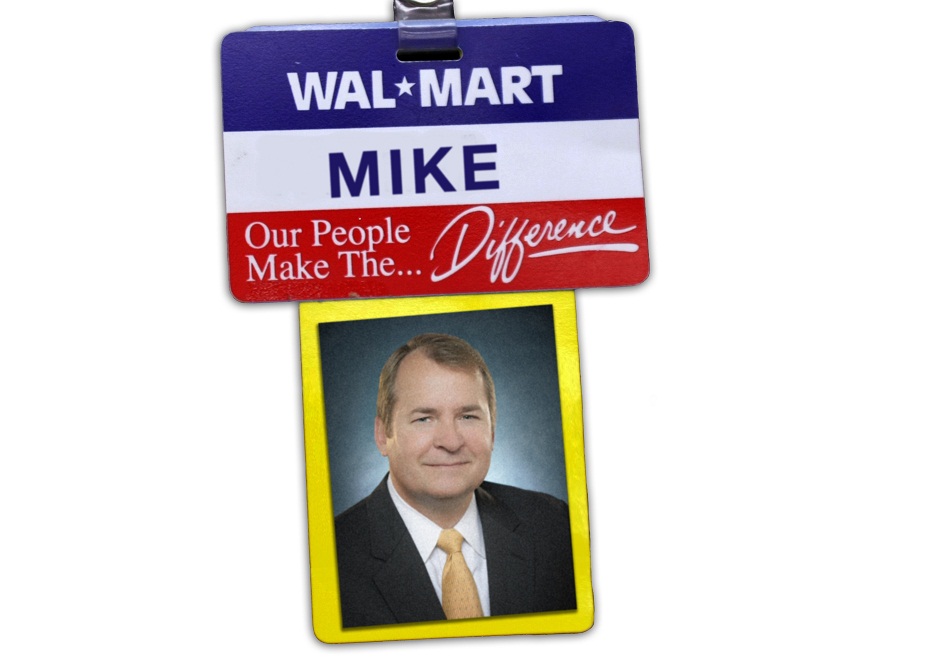

Business Impact
The Most Powerful Man in Payments
The race towards mobile payments stops at Mike Cook’s desk in Arkansas.

Many technology companies think mobile phones will revolutionize how we pay at retail stores. For that to happen, they’ll have to make it past the desk of Mike Cook in Bentonville, Arkansas.
And Mike’s a little skeptical.
Cook, 47, is the person who decides how people pay at Wal-Mart Stores, the world’s largest retailer. A small-town Missouri native with a forgettable title (VP and assistant treasurer), Cook directly oversees the collection of nearly half a trillion dollars in cash, credit and coupons from customers around the globe each year.
That’s more than the GDP of Sweden and explains why so many technology companies are now courting Wal-Mart: a deal with the giant retailer could make the fortunes of any company hawking a new form of payment.
But Cook says he isn’t necessarily looking for a digital revolution. He is looking for ways to save Wal-Mart and its customers some money: “A lot of [what I do] is thinking about how to make big and small improvements on our volume that come out to significant dollar savings.” A 20-year veteran who has worked at Wal-Mart’s headquarters for so long he has trouble remembering his first job (assistant cash manager), he calls payments “the most complex simple game on earth.”
“I think it’s probably boring to most people, but I find it invigorating,” says Cook.
And it’s getting more complicated. Wal-Mart is now in the middle of a brewing fight over who will control payments made from smart phones. Such mobile payments are expected to soar to $670 billion globally by 2015—and companies such as PayPal, Google, and Verizon are jockeying to provide mobile-phone wallets that will give them leverage over fees, as well as detailed data about consumers’ shopping habits.
Breaking into Wal-Mart’s network could help any one of them dominate. This month, however, the Wall Street Journal reported that Wal-Mart, Target, and a dozen other big retailers are joining together to study the possibility of a merchant-led mobile wallet that would compete with those from tech companies.
Cook, who confirmed the broad outlines of the plan, says Wal-Mart has doubts about the technology firms’ intentions. “Would you want some telco provider or some technology provider knowing all of your prescription goods that you purchased at Walgreens or Walmart?” he says. “It’s not as though we’re not excited about mobile. It’s that we’re not excited about the solutions that are out there.”
When Cook started (he served as an inspector for the U.S. Treasury before landing in the accounting department), Wal-Mart’s sales were $55 billion at about 2,000 stores; those figures have risen to $443 billion and more than 10,000 stores today. Back then, an expansion beyond U.S. borders had just begun; now, Wal-Mart is in 27 countries and handles more than 200 million customer transactions a week.
To make it past Cook’s desk, first a product or proposal has to get there. That is not easy. Today, companies that vie for Cook’s attention range from executives at the world’s largest wireless carriers to, he says, “two guys in a garage who have a solution they think is the greatest thing since sliced bread.”
His to-do list is jammed with other multimillion-dollar issues, from the latest card-processing agreement in Brazil to the problem of robbers who have been targeting the armored cars that pick up cash at U.S. stores.
Wal-Mart is known for wielding its market power to force down prices, and payment systems are no exception. The company has spent much of the last decade locked in negotiations and courtroom battles with card networks like Visa over fees, fraud risks, and security standards.
The latest ideas from Silicon Valley are getting a similar treatment. If a technology doesn’t save Wal-Mart money, Cook calls it a “show stopper coming in the door.” Otherwise, he and his team of nearly three dozen employees consider whether the technology can improve the shopper’s experience or the security of transactions.
“Our objective is to make [paying] more efficient, thereby lowering our costs,” says Cook. Lower costs mean Wal-Mart can lower prices, which leads to more sales and yet more leverage to make suppliers reduce prices—a cycle people at the company call the “productivity loop.”
Cook’s team includes MBAs and CPAs, as well as industrial engineers who clock to the millisecond how long it takes a customer to hand a card to a cashier and for the money to enter Wal-Mart’s accounts. For example, every additional second it takes customers to pay at its U.S. stores costs Wal-Mart an average of $12 million in cashier wages, CFO Charles Holley said last month while announcing that Wal-Mart would introduce more self-checkout lanes where shoppers scan their own items.
The sliced-bread makers, Cook says, often don’t appreciate the complexity of Wal-Mart’s existing mix of sales terminals, including gas pumps, drive-throughs, and registers—nor the sheer size of its operations. “The unfortunate part is that people don’t envision the volume that we would create for them,” he says.
They may also underestimate the importance of cash to his stores’ shoppers. Although options for paying today have multiplied, credit cards still account for less than 15 percent of Wal-Mart’s total transactions. Cook says that shows things change more slowly than people think. Recently, he’s actually been working to make cash payments easier for Wal-Mart to accept—for example, by filling store ATMs with money collected at cash registers.